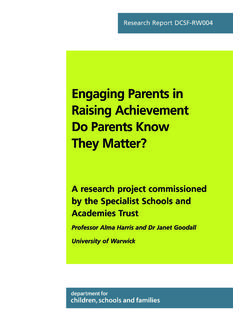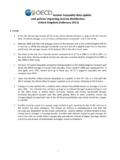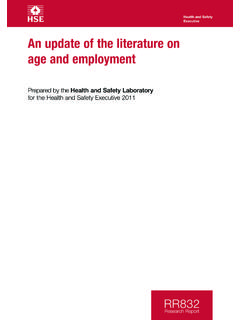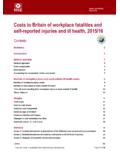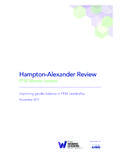Transcription of The Impact of School Leadership on Pupil Outcomes
1 Research Report DCSF-RR108. The Impact of School Leadership on Pupil Outcomes Final Report Christopher Day1, Pam Sammons1, David Hopkins2, Alma Harris2, Ken Leithwood3, Qing Gu1, Eleanor Brown1, Elpida Ahtaridou2 and Alison Kington1. 1 University of Nottingham 2 Institute of Education, University of London 3 University of Toronto Research Report No DCSF-RR108. The Impact of School Leadership on Pupil Outcomes Final Report Christopher Day1, Pam Sammons1, David Hopkins2, Alma Harris2, Ken Leithwood3, Qing Gu1, Eleanor Brown1, Elpida Ahtaridou2 and Alison Kington1. 1. University of Nottingham 2. Institute of Education, University of London 3. University of Toronto The views expressed in this report are the authors' and do not necessarily reflect those of the Department for Children, Schools and Families.
2 University of Nottingham 2009. ISBN 978 1 84775 445 5. June 2009. CONTENTS. Acknowledgements xi Executive Summary 1. Chapter 1 The Research Context and Literature Update Background to the Study 6. Aims 6. Organisation of the Research 7. The Interim Report 9. Summary of Relevant Research Reported Since the Initial Literature 9. Review Chapter 2 Research Design and Methods Introduction 16. A Mixed Methods Design 16. Sampling Strategy: Identifying Effective and Improved Schools 19. School Improvement Groups 20. Analysis Strategies 22. Analysis of the Qualitative Data 22. Summary 26. Chapter 3 Aims, Leadership Characteristics and Practices in Schools with Different Effectiveness and Improvement Profiles Introduction 27. The Questionnaire Survey Sample - Introduction 27.
3 The Survey and Response Rates 28. Leadership Characteristics and Practices in Relation to School 29. Improvement Groups School SES Context 29. Heads' Experience 30. Leadership Distribution 31. The Role of the SMT / SLT 32. i The Contribution of Other Groups to School Leadership 32. School Conditions: Academic Press 33. School Conditions: Collaborative Cultures and Parental Engagement 34. Perceptions of Improvement 35. Actions Identified by Heads as Most Important in Promoting School 40. Improvement Descriptive Analyses 40. Findings 42. Key Messages 42. Chapter 4 Heads Actions and Leadership Distribution in Schools in Different Contexts Introduction 45. Heads' Leadership Actions 46. Engagement with External Programmes and Activities 54.
4 Sharing Responsibility for Decision Making 57. Major Challenges in Different Phases of Headship 59. Areas of Greatest Improvements under the Leadership of Current Head: 62. Perceptions of Key Staff Impact of Improvements on Pupil Outcomes : Perceptions of Heads 63. Important Leadership Qualities: Key Staff Perceptions 68. Findings 69. Chapter 5 Models of the Impact of Leadership on Improvement in Pupil Outcomes : Results from Structural Equation Modelling Introduction 72. Model Building: Structural Equation Modelling 72. The Factor-Analytical Model 72. Analysing Other CFA Measurement Models in the Wave 1 Heads' 79. Survey Models of Leadership : The Structural Model 89. Findings 95. ii Chapter 6 Pupils' views of the School Experience: An Analysis of Social and Affective Outcomes Introduction 99.
5 Analysis of Pupil Questionnaire Data 100. Comparing Pupil Views by School Phase and Context 104. Links Between Results from the Survey of Pupil Views and the 105. Analytical Case Study Data Findings 109. Chapter 7 Leadership Values and Strategies Introduction 110. Defining the Vision 111. Improving Conditions for Teaching and Learning 113. Redesigning Organisational Structures, Redefining Roles and 115. Responsibilities Enhancing Teaching and Learning 118. Re-Designing and Enriching the Curriculum 120. Enhancing Teacher Quality 121. Establishing Relationships Within the School Community 123. Building Relationships Outside the School Community 124. Findings 126. Chapter 8 Phases of Success: The Layering of Leadership Introduction 128.
6 Cross-Phase Consistencies: Seven Strategies 130. The Contextualisation of Success: Layering Leadership Strategies 135. Findings 148. Chapter 9 Two Case Studies: The Layering of Success 91. Introduction 149. Greenpark Primary School 149. Eyhampton High School 166. iii Findings 180. Chapter 10 How the Study has Advanced Knowledge about Relationships between Effective Headship and Pupil Outcomes : Twelve New Claims and their Implications for Policy and Practice Introduction 182. Claims 183. Effective Leadership and Pupil Outcomes : Policy and Practice 191. Implications Direct Policy Influence 192. The Confluence of Societal needs and Professional Practice: The 193. Challenges Facing School Leaders The Moral Purpose of Leadership 194.
7 Conclusions 195. References 196. End Notes 202. Appendices (see separate document). iv Index of Figures Chapter 2. Figure 2-1 An initial framework to guide research on Leadership effects 16. Figure 2-2 Research design 17. Figure 2-3 Sampling strategies 22. Chapter 3. Figure 3-1 Number of heads in post over last decade School and improvement 30. group (secondary). Chapter 5. Figure 5-1 Correlations between the four dimensions (latent variables) in 74. relation to Leadership practice (primary) (N=378). Figure 5-2 Correlations between the five latent variables in relation to Leadership 77. practice (secondary). Figure 5-3 The structural model of Leadership practice (secondary) (N=309) 90. Figure 5-4 SEM based on heads perception of Leadership practices and 92.
8 Changes in Pupil Outcomes over three years (2003-05), with standardised solution displayed (secondary). Figure 5-5 The structural model of Leadership practice (primary) 93. Figure 5-6 SEM based on heads perceptions of Leadership practices and 98. changes in Pupil Outcomes over three years (2003-05), with standardised solution displayed (primary). Chapter 7. Figure 7-1 Strategies for improving student learning 127. Chapter 8. Figure 8-1 Restructuring the SLT - priority strategy 139. Figure 8-2 Using data - priority strategy 143. Figure 8-3 Curriculum personalisation and enrichment - priority strategy 145. Chapter 9. Figure 9-1 Head line of success - Greenpark Primary School 152. v Figure 9-2 Evidence of layered Leadership 165.
9 Figure 9-3 Head line of Leadership success - Eyhampton High School 168. Figure 9-4 Evidence of layered Leadership 181. Chapter 10. Figure 10-1 Secondary School Leadership practices and changes in Pupil 187. Outcomes over three years: a structural equation model Figure 10-2 A research informed model of dimensions of effective School 191. Leadership for School improvement vi Index of Tables Chapter 1. Table 1-1 An overview of phases of activity 8. Chapter 2. Table 2-1 Wave 1 survey Primary and Secondary School Samples by School FSM 20. band Table 2-2 Wave 1 survey response rate (heads) 20. Table 2-3 Key staff at School level 20. Table 2-4 Key staff at questionnaire level 20. Table 2-5 School context (FSM band) and secondary School improvement group 21.
10 Chapter 3. Table 3-1 Responses to the head survey by School improvement groups 29. Table 3-2 School SES contexts (FSM band) and changes of head (secondary) 31. Table 3-3 Improvement groups and secondary heads responses to pupils' missing 35. class Table 3-4 Heads' perceptions of change in School conditions (primary) 37. Table 3-5 Heads' perceptions of change in School conditions (secondary) 37. Table 3-6 Improvement groups and primary heads' responses to reduction in staff 38. mobility'. Table 3-7 Improvement groups and secondary heads' responses to reduction in 38. staff mobility'. Table 3-8 Primary heads' responses to three most important actions/strategies used 41. to effect improvement in the last three years by School improvement group vii Table 3-9 Secondary heads' responses to three most important actions/strategies 41.









